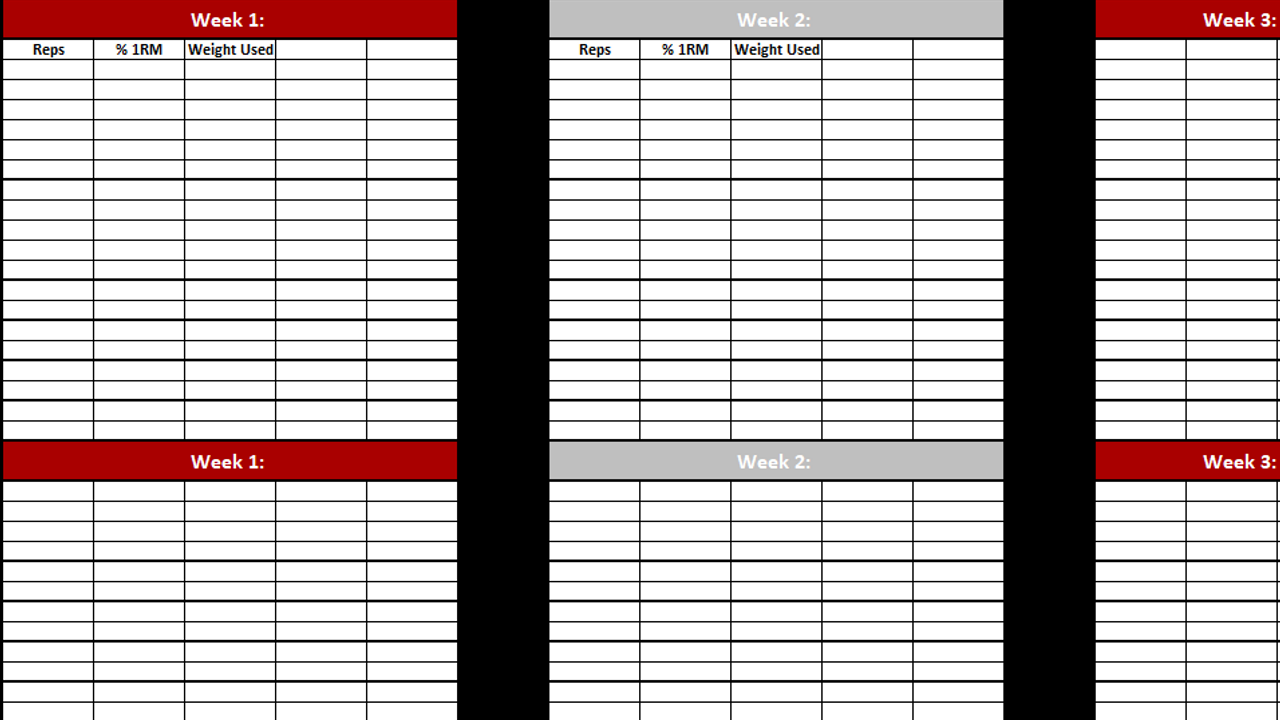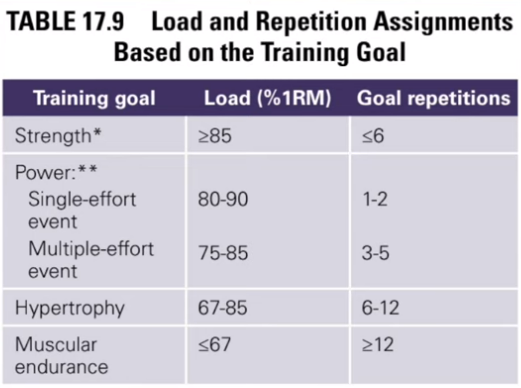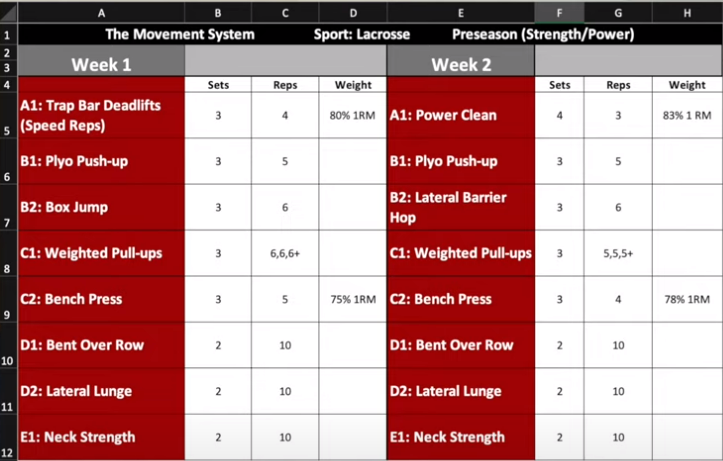CSCS Program Design | How to Program Based on %1RM with Example Program
Sep 13, 2022
Edited by: Danielle Abel
Principles of Program Design
To lay the foundation, when we're talking about programming based upon % of 1RM, we're talking about program design. Program design can be easily confused with periodization, which is more of a long-term, month-over-month, block-to-block, concept.
Thinking about it from a single program perspective makes the concept of programming based upon % of 1RM much less overwhelming.
Along with % of 1RM, you should also be thinking about
- Exercise Selection
- Sets
- Reps
A good starting place is Table 17.7 from the NSCA's Essentials of Strength Training and Conditioning textbook.

This chart shows the maximum number of reps allowed for any percentage of 1RM. Keep in mind that variations will occur from athlete to athlete. For example, an athlete should be able to do about 8 reps using a load that's 80% of their one rep max.
However, just because the athlete "can" do 8 reps at 80% doesn't mean we would want to program at that level. Meaning, that during week 1 of a training block, you would want to start at a lesser percentage to avoid fatigue (it would be like doing a 1RM on week 1 of your training program) and allow them to make progressions over the course of the training block.
Keep in mind the chart represents the most number of reps that the athlete can do.
Practical Application
To help you determine what % of 1RM to program, you'll want to use a different chart to align the load with the training goal.

Let's break this down even further, with logic and goal driven examples.
Programming Strength
- Strength = high intensity and low volume
- According to Table 17.9, Strength = 85% of 1RM at less than or equal to 6 reps (if you refer to the first chart, Table 17.7 and line up 85% it correlates with 6 reps so this makes sense)
From a program design perspective, some ideas here could be starting at 5x5 at 80% of their 1RM or starting at 5x4 at 82% 1RM and working upwards closer to their 1RM over the course of the training block.
Keep in mind there is no exact way to do this; it's more about being able to manage fatigue & promote recovery so that the athlete is not lifting with high intensities week over week, over week.
Looking for a step-by-step program to help you design great training programs? Then you might want to check out our online Program Design 101 Course here.
Programming Power
If the goal of the training block is power, then we need to determine if the sport requires single-effort tasks or multiple-effort tasks.
From here, we can choose the associated load and rep range that correlates to the goal of the sport.
- Keep in mind that you wouldn't want to start at the highest level that the athlete "could" do, instead intentionally programming load and reps under what "could be" done and gradually working your way up.
Ideally, within a power block, programming about 50% (half) of 1RM seems to be ideal because this keeps both speed and strength high.
Programming for Hypertrophy
Hypertrophy has a slighter wider load and rep range.
- 67-85% 1RM
- 6-12 reps
For example, you could do 5 sets of 8 reps at 75% of 1RM, because this would keep the level of intensity below the maximum load and rep range. Starting the program at this level would allow the athlete to recover well but still be working near failure, which is what has been shown in the literature to be the most important for hypertrophy.
In general, a good rule of thumb is to go 1 or 2 reps below what they could do to lower the intensity from the maximal level.
Programming for Muscular Endurance
Programming endurance allows even greater load and rep ranges.
- Less than or equal to 67% 1RM
- Greater than or equal to 12 reps
With endurance, we still want to come in under the level of intensity that the athlete could go. For example, maybe you program 3 sets of 15 at 60% of their 1RM load, knowing that 67% is the highest you should go.
Knowing that endurance is focused more on volume with less intensity, the above example aligns with what we know about high-volume tasks - you can't lift heavy loads for high volume!
Program Design Examples
Let's apply what we've gone through so far using the Lacrosse program example below.

This is a preseason program that's focused on strength & power. When we look at Week 1, the Trap Bar deadlifts are to be performed using a high rate of speed (velocity = moving the load quickly) to promote power.
- 3 sets of 4 reps at 80% of 1RM - referring back to Table 17.7 (% of 1RM & Relationships Allowed), it shows at 80%, there are 8 reps allowed
- Knowing that Power phases should be programmed at about 50% of what the athlete could do, the goal of 4 reps is 50% of what the athlete could lift
It might also be helpful to highlight the order of exercise performance here. The A1 represents a straight set where the athlete would perform all of the deadlifts sets singularly before moving on to the next exercise.
Whereas compared to the Plyo-Push Up and Box Jump, these exercises are represented as B1/B2 and are superset or combined together, meaning the athlete would perform both exercises together before resting.
Other Programming Tips
Keep in mind the reps for the Box Jump, Weighted Pull-Ups, and Bench Press are all programmed with strength and power in mind, meaning less volume and higher intensity. Knowing that this program is a preseason program, we would want to be mindful of this to manage workload and recovery ability.
Keep in mind with the Bench Press, we want to focus on the speed and strength of that movement and that we're not as concerned about how heavy the athlete can lift the loads. Since we're focusing on power, we want to see how quickly they can move the "heavy" load.
Lastly, the Rows, Lateral Lunges, and Neck Strength are accessory patterns to balance out the other opposing movements that the program started with (a squat pattern to balance out the hingeing and rowing to balance out the push-ups).
In general, the first 4 to 6 exercises of a program should be related to the primary objective of training, with the remainder of the movements going to secondary movements or targeting certain accessories that are important to the sport or to the athlete.
Keep in mind with week-to-week progressions, the volume in this training program above will come down, and the intensity will go up since that's the goal of high-intensity training (reduce the volume and increase the intensity) to be able to manage fatigue well.
The volume reductions and intensity progressions further align with a linear periodization model as well. To learn more about periodization, you might want to check out our Course below.
Support & Courses Available
Ready for even more support? Our Program Design 101 Course teaches you exactly how to organize an annual training plan, provides sport-specific examples and % of 1RM and RPE considerations included, and even includes done-for-you programming templates by phase. Click the link here to check it out.
Stay connected with news and updates!
Join our mailing list to receive the latest news and updates from our team.
Don't worry, your information will not be shared.
We hate SPAM. We will never sell your information, for any reason.

